
Happy New Year!
We are in the doldrums of January – the long, dark and usually coldest month of winter. January probably gets a bad wrap because it follows the festive season that occurs from Thanksgiving through Christmas. At the Svenningsen farm, we like January! We sell our calves the first week and our outside workload cuts down dramatically after that. We also have a family ski trip planned every January – a special time with our adult children and grandkids. Whether you are hunkered down in your home or enjoying a much deserved break from the cold – our FSA employees are busy getting ready for this upcoming year. They are participating in training for the two new programs that will be available for sign up on January 23rd: ERP Phase 2 and PARP. Please see the additional information about these programs found in the articles below.
Our farm loan officers are busy preparing for a new round of applications. If you think you would like to utilize some of the different types of loans that we have available at FSA, a great way to start is by using our new loan application tool. This tool will help you determine what type of loan may best fit your needs and it has the added bonus of actually reducing the amount of information we use to require on an application. It’s important to start early if you will need financing for this crop year. Farmers can access the Loan Assistance Tool by visiting farmers.gov/farm-loan-assistance-tool and clicking the ‘Get Started’ button.
Last but not least, we are trying to fill some vacant County Executive Director (CED) positions, by hiring location specific. We are currently advertising for County Executive Director Trainees (CEDT’s) in the following four counties: Renville, Mountrail, Stutsman and Hettinger. Anyone inside or outside FSA, can apply for one of those four openings. Referred candidates will then be interviewed by the State Committee and the local County Committee where they would like to work. If hired, they will receive one year of training, while knowing where they will be working. We intend to keep the training sites closer to their home county as well. If you know someone who would be a good candidate for the County Executive Director position in one of those four counties – please let them know about this great opportunity. You can also check out the job posting for more information and to apply by January 20, 2023.
That’s all for this month – stay warm – February is on the way!
- Marcy Svenningsen
Policy changes will help more producers recover from natural disasters
The U.S. Department of Agriculture (USDA) made updates to several conservation, livestock and crop disaster assistance programs to give more farmers, ranchers, and tribes the opportunity to apply for and access programs that support recovery following natural disasters. Specifically, USDA’s Farm Service Agency (FSA) expanded eligibility and enhanced available benefits for a suite of its programs. These updates will provide critical assistance to producers who need to rebuild and recover after suffering catastrophic losses of production and infrastructure due to natural disasters.
FSA has updated the following programs: The Emergency Conservation Program (ECP), the Emergency Forest Restoration Program (EFRP), the Emergency Assistance for Livestock, Honeybees, and Farm-raised Fish (ELAP), the Livestock Forage Disaster Program (LFP), the Livestock Indemnity Program (LIP) and the Noninsured Crop Disaster Assistance Program (NAP).
Conservation Disaster Assistance Updates
FSA updated ECP to:
- Allow producers who lease Federally owned or managed lands, including tribal trust land, as well as State land the opportunity to participate.
- Provide advance payments, up to 25% of the cost, for all ECP practices before the restoration is carried out, an option that was previously only available for fence repair or replacement. The cost-share payment must be spent within 60 days.
Additionally, Congress also authorized the Federal government to pay 100% of the ECP and EFRP cost for damage associated with the Hermit’s Peak/Calf Canyon Fire in New Mexico. This fire burned over 340,000 acres from April 2022 to June 2022 and was the largest wildfire in recorded history in New Mexico. ECP and EFRP cost-share assistance is typically capped at 75%. This policy change for 100% cost-share applies only to those locations impacted by the Hermit’s Peak/Calf Canyon Fire.
ECP and EFRP provide financial and technical assistance to restore conservation practices like fencing, damaged farmland or forests.
Livestock Disaster Assistance Updates
FSA also expanded eligible livestock under ELAP, LFP and LIP. Specifically, horses maintained on eligible grazing land are eligible for ELAP, LFP and LIP. Many family farms and ranches use their forage to raise horses to augment their other agriculture endeavors. FSA recognizes that animals maintained in a commercial agriculture operation, add value to the operation and could be available for marketing from the farm. FSA regulations have been updated to include these animals as eligible livestock
Horses and other animals that are used or intended to be used for racing and wagering remain ineligible.
Ostriches are also now eligible for LFP and ELAP. FSA is making this change because ostriches satisfy more than 50% of their net energy requirement through the consumption of growing forage grasses and legumes and are therefore considered “grazing animals”.
This change for ostriches is effective for the 2022 program year for both LFP and ELAP. ELAP requires a notice of loss to be filed with FSA within 30 days of when the loss is first apparent. Because this deadline may have passed for 2022, FSA is extending the deadline for filing notices of loss through March 31, 2023.
LIP and ELAP reimburses producers for a portion of the value of livestock, poultry and other animals that died as a result of a qualifying natural disaster event or for loss of grazing acres, feed and forage. LFP provides benefits for grazing losses due to drought and eligible wildfires on federally managed lands.
Noninsured Crop Disaster Assistance
NAP provides financial assistance to producers of non-insurable crops when low yields, loss of inventory or prevented planting occur due to natural disasters. Basic NAP coverage is equivalent to the catastrophic level risk protection plan of insurance coverage, which is based on the amount of loss that exceeds 50% of expected production at 55% of the average market price for the crop.
Previously, to be eligible for NAP coverage, a producer had to submit an application (Form CCC-471) for NAP coverage on or before the application closing date. For 2022, if a producer has a Socially Disadvantaged, Limited Resource, Beginning and Veteran Farmer or Rancher Certification (Form CCC-860) on file with FSA, it will serve as an application for basic coverage for all eligible crops having a 2022 application closing date and all NAP-related service fees for basic coverage will be waived for these producers.
FSA will notify all eligible producers who already have the CCC-860 certification form on file of their eligibility for NAP basic coverage for 2022. To potentially receive NAP assistance, producers who suffered losses due to natural disasters in 2022 should file an acreage report as well as a notice of loss with the FSA at their local Service Center.
Producers who are interested in obtaining NAP coverage for 2023 and subsequent years should also contact their local FSA county office for information on eligibility, coverage options and applying for coverage.
Reporting Losses
Producers impacted by a natural disaster should report losses and damages and file an application with their FSA county office. Timelines for reporting losses and applying for payments differ by program.
For LIP and ELAP, producers will need to file a Notice of Loss for livestock and grazing or feed losses within 30 days and honeybee losses within 15 days. For LFP, producers must provide a completed application for payment and required supporting documentation to their FSA office within 30 calendar days after the end of the calendar year in which the grazing loss occurred.
For NAP, producers should contact their local FSA office for guidelines on submitting a notice of loss and filing an acreage certification.
More Information
The updates to these programs build on other Biden-Harris administration efforts to improve disaster assistance programs, including additional flexibility in obtaining Noninsured Crop Disaster Assistance Program (NAP) basic coverage for socially disadvantaged, beginning, limited resource and veteran farmers and ranchers.
Previous enhancement to the ELAP provide program benefits to producers of fish raised for food and other aquaculture species as well as cover above normal expenses for transporting livestock to forage and grazing acres and transport feed to livestock impacted by qualifying drought. And earlier updates to the LIP payment rates better reflect the true market value of non-adult beef, beefalo, bison and dairy animals.
Recently, FSA announced it would begin accepting applications for the Emergency Relief Program (ERP) Phase Two and the new Pandemic Assistance Revenue Program (PARP) on Jan. 23, 2023, through June 2, 2023. ERP Phase Two is designed to fill gaps in the delivery of program benefits not covered in ERP Phase One and improves equity in program delivery to underserved producers. PARP will help address gaps in previous pandemic assistance, which was targeted at price loss or lack of market access, rather than overall revenue losses. Learn more in the Jan. 9, 2023 news release.
Additional Resources
On farmers.gov, the Disaster Assistance Discovery Tool, Disaster Assistance-at-a-Glance fact sheet, and Farm Loan Discovery Tool can help producers and landowners determine program or loan options. For assistance with a crop insurance claim, producers and landowners should contact their crop insurance agent. For FSA and Natural Resources Conservation Service programs, contact the local USDA Service Center.
The U.S. Department of Agriculture (USDA) reminds agricultural producers with perennial forage crops of an option to report their acreage once, without having to report that acreage in subsequent years, as long as there are no applicable changes on the farm. Interested producers can select the continuous certification option after USDA’s Farm Service Agency (FSA) certifies their acreage report.
An acreage report documents a crop grown on a farm or ranch and its intended uses, including perennial crops like mixed forage, birdsfoot trefoil, chicory/radicchio, kochia (prostrata), lespedeza, perennial peanuts and perennial grass varieties. To access many USDA programs, producers must file an accurate and timely acreage report for all crops and land uses, including failed acreage and prevented planting acreage.
The perennial crop continuous certification process requires a producer to initially complete an acreage report certifying the perennial crop acreage. The producer may select the continuous certification option any time after the crop is certified. Once the continuous certification option is selected, the certified acreage will roll forward annually and does not require additional action on the producer’s part in subsequent years unless the acreage report changes.
Once an producer selects continuous certification, then continuous certification is appliable to all fields on the farm for the specific crop, crop type and intended use. If continuous certification is selected by any producers sharing in the crop, then the continuous certification is appliable to fields in which the producer has a share for the specific crop, crop type and intended use.
Producers can opt out of continuous certification at any time. The continuous certification will terminate automatically if a change in the farming operation occurs.
How to File a Report
To file a crop acreage report, producers need to provide:
- Crop and crop type or variety.
- Intended use of the crop.
- Number of acres of the crop.
- Map with approximate boundaries for the crop.
- Planting date(s).
- Planting pattern, when applicable.
- Producer shares.
- Irrigation practice(s).
- Acreage prevented from planting, when applicable.
- Other information as required.
More Information
Producers can contact their local FSA office to see if their crops are eligible for continuous certification or to make an appointment. Producers can make an appointment to report acres by contacting their local USDA Service Center.
New Programs Will Provide Additional Pandemic and Natural Disaster Assistance for 2020 and 2021; Deadline Announced for Previous Emergency Relief
Agriculture Secretary Tom Vilsack announced recently plans for additional emergency relief and pandemic assistance from the U.S. Department of Agriculture (USDA). USDA is preparing to roll out the Emergency Relief Program (ERP) Phase Two as well as the new Pandemic Assistance Revenue Program (PARP), which are two programs to help offset crop and revenue losses for producers. USDA is sharing early information to help producers gather documents and train front-line staff on the new approach.
ERP Phase Two will assist eligible agricultural producers who suffered eligible crop losses, measured through decreases in revenue, due to wildfires, hurricanes, floods, derechos, excessive heat, winter storms, freeze (including a polar vortex), smoke exposure, excessive moisture and qualifying droughts occurring in calendar years 2020 and 2021.
PARP will assist eligible producers of agricultural commodities who experienced revenue decreases in calendar year 2020 compared to 2018 or 2019 due to the COVID-19 pandemic. PARP will help address gaps in previous pandemic assistance, which was targeted at price loss or lack of market access, rather than overall revenue losses.
Emergency Relief Program Phase Two ERP is authorized under the Extending Government Funding and Delivering Emergency Assistance Act, which includes $10 billion in assistance to agricultural producers impacted by wildfires, droughts, hurricanes, winter storms and other eligible disasters experienced during calendar years 2020 and 2021.
Phase Two builds on ERP Phase One, which was rolled out in May 2022 and has since paid more than $7.1 billion to producers who incurred eligible crop losses that were covered by federal crop insurance or Non-insured Crop Disaster Assistance Program.
ERP Phase Two includes producers who suffered eligible losses but may not have received program benefits in Phase One. To be eligible for Phase Two, producers must have suffered a loss in allowable gross revenue as defined in forthcoming program regulations in 2020 or 2021 due to necessary expenses related to losses of eligible crops from a qualifying natural disaster event.
Eligible crops include both traditional insurable commodities and specialty crops that are produced in the United States as part of a farming operation and are intended to be commercially marketed. Like other emergency relief and pandemic assistance programs, USDA’s Farm Service Agency (FSA) continues to look for ways to simplify the process for both staff and producers while reducing the paperwork burden. The design of ERP Phase Two is part of that effort.
In general, ERP Phase Two payments are expected to be based on the difference in certain farm revenue between a typical year of revenue as will be specified in program regulations for the producer and the disaster year. ERP Phase Two assistance is targeted to the remaining needs of producers impacted by qualifying natural disaster events, while avoiding windfalls or duplicative payments. Details will be available when the rule is published later this year.
Deadline for Emergency Relief Program Phase One Producers who received a letter dated December 16, 2022, indicating that their ERP Phase One prefilled applications was updated due to corrections or other circumstances, have until January 20, 2023 to contact FSA at their local USDA Service Center to receive program benefits.
Pandemic Assistance Revenue Program PARP is authorized and funded by the Consolidated Appropriations Act of 2021.
To be eligible for PARP, an agricultural producer must have been in the business of farming during at least part of the 2020 calendar year and had a certain threshold decrease in allowable gross revenue for the 2020 calendar year, as compared to 2018 or 2019. Exact details on the calculations and eligibility will be available when the forthcoming rule is published.
How Producers Can Prepare ERP Phase Two and PARP will use revenue information that is readily available from most tax records. FSA encourages producers to have their tax documents from the past few years and supporting materials ready, as explained further below. Producers will need similar documentation to what was needed for the Coronavirus Food Assistance Program (CFAP) Phase Two, where a producer could use 2018 or 2019 as the benchmark year relative to the disaster year.
In the coming weeks, USDA will provide additional information on how to apply for assistance through ERP Phase Two and PARP. In the meantime, producers are encouraged to begin gathering supporting documentation including:
- Schedule F (Form 1040); and
-
Profit or Loss from Farming or similar tax documents for tax years 2018, 2019, 2020, 2021 and 2022 for ERP and for calendar years 2018, 2019 and 2020 for PARP.
Producers should also have, or be prepared to have, the following forms on file for both ERP and PARP program participation:
- Form AD-2047, Customer Data Worksheet (as applicable to the program participant);
- Form CCC-902, Farm Operating Plan for an individual or legal entity;
- Form CCC-901, Member Information for Legal Entities (if applicable); and
- Form AD-1026 Highly Erodible Land Conservation (HELC) and Wetland Conservation (WC) Certification.
Most producers, especially those who have previously participated in FSA programs, will likely have these required forms on file. However, those who are uncertain or want to confirm should contact FSA at their local USDA Service Center.
In addition to the forms listed above, underserved producers are encouraged to register their status with FSA, using Form CCC-860, Socially Disadvantaged, Limited Resource, Beginning and Veteran Farmer or Rancher Certification, as certain existing permanent and ad-hoc disaster programs provide increased benefits or reduced fees and premiums.
Through proactive communications and outreach, USDA will keep producers and stakeholders informed as program eligibility, application and implementation details unfold.

Today, at the American Farm Bureau Federation annual convention, Agriculture Secretary Tom Vilsack announced several major developments at the U.S. Department of Agriculture that will benefit farmers, ranchers and producers across the nation.
“At USDA, our goal is to provide all farmers, including new and underserved producers, with the opportunity to receive the assistance they need to continue farming, to build and maintain their competitive-edge, and to access more, new, and better markets,” said Vilsack, who spoke at the American Farm Bureau Federation annual convention today. “Working together we can ensure American agriculture is as resilient as ever and will do so by implementing a holistic approach to emergency assistance, by lowering input costs through investments in domestic fertilizer production, and by promoting competition in agricultural markets.”
Secretary Vilsack announced that USDA continues to make progress in the following areas by:
-
Assisting producers facing high input costs to access domestic, innovative fertilizer capacity.
-
Improving risk protection for underserved producers.
- Investing in new choices and meat processing capacity for livestock producers.
-
Providing relief for producers impacted by disaster and the pandemic.
These programs and efforts are part of the Biden-Harris Administration’s commitment to lower costs for producers, increase competition and access to market opportunities, and ensure equity in designing and developing programs to help all producers. Additionally, the announcements are a continuation of the Biden-Harris Administration’s focus on targeting assistance based on need, reaching everyone who is eligible, and removing the bureaucratic burden on producers.
USDA Moving Forward with Fertilizer Production Expansion Program; Publishes Comments on Importance of Increased Competition
USDA will soon begin accepting public comments on environmental and related aspects of 21 potentially viable projects to increase fertilizer production across the United States totaling up to $88 million. These applicants have requested grant funding through the first round of the Department’s newly established Fertilizer Production Expansion Program. This program is one of many ways the Biden-Harris Administration invests in the agricultural supply chain right here at home. Investing in projects to increase fertilizer production will bring production and jobs back to the United States, promote competition and support American goods and services. Under the leadership of President Biden and Vice President Harris, USDA continues to create a competitive, resilient, secure and sustainable economy to support opportunities for local businesses and people across this nation. The Fertilizer Production Expansion Program is a critical part of that effort.
The Department is considering fertilizer production projects in Alabama, Arizona, Colorado, Florida, Iowa, Louisiana, Massachusetts, Minnesota, Missouri, Montana, Ohio, Oregon, Texas, Washington, and Wisconsin. In response to prior feedback requesting more time for public comment on the environmental and related impact of USDA-funded projects, USDA is seeking comments from the public on the following questions and projects pertaining to the National Environmental Policy Act of 1969 (NEPA) and Section 106 of the National Historic Preservation Act of 1966 (NHPA). The 30-day public comment period will close February 8, 2023. Additional information is available at www.rd.usda.gov/fpep-environmental-review-comments.
The Fertilizer Production Expansion Program is part of a whole-of-government effort to promote competition in agricultural markets. USDA has also released a summary of the comments received through a Request For Information on Access to Fertilizer: Competition and Supply Chain Concerns, which highlights the variety of concerns about the limited competition and dependence of foreign sources for significant amounts of fertilizer.
Improving Risk Protection for Beginning, Veteran, Limited Resource and Minority Producers
The Noninsured Crop Disaster Assistance Program (NAP) provides financial assistance to producers of non-insurable crops when low yields, loss of inventory or prevented planting occur due to natural disasters. There is a Congressionally mandated fee waiver for basic coverage for underserved producers. However, a previous set of procedures and regulations created a paperwork burden that stood in the way of many producers taking advantage of the basic coverage option. The recent rule removes barriers and establishes procedures through which an underserved producer with a CCC-860, Socially Disadvantaged, Limited Resource, Beginning and Veteran Farmer or Rancher Certification, on file prior to the applicable NAP application closing date will automatically receive basic coverage for any NAP-eligible crops they plant. Underserved producers on file for 2022 will also receive retroactive basic coverage. Like all other covered producers, underserved producers will still need to file a notice of loss and apply for benefits.
In addition to the basic catastrophic level coverage under NAP, producers can buy-up higher levels of coverage by paying a premium. Underserved producers receive a 50 percent discount on any premiums. Producers who are interested in obtaining NAP coverage for 2023 should also contact their local FSA county office for information on eligibility, coverage options and applying for coverage. FSA also plans to target outreach to previous producers of NAP-eligible crops to ensure these producers are aware of their options. For more information, reference our NAP Fact Sheet.
USDA Making More Investments in Meat and Poultry Processing
USDA is investing more than $12 million to expand independent meat and poultry processing capacity in Ohio, Michigan and Minnesota. Vilsack announced that Meat and Poultry Processing Expansion Program grants will help fund the following projects:
- In Ohio, International Food Solutions Inc. is receiving $9,575,250 to help redevelop and expand a vacant building in Cleveland into a plant with the capacity to process 60 million pounds of poultry. The expansion will include cold and dry storage and two processing lines. The project will create 227 good-paying jobs. International Food Solutions is a woman- and minority-owned business that has produced thousands of prepared meals for K-12 students receiving free and reduced-price school meals.
- In Michigan, grower-owned cooperative Michigan Turkey Producers is receiving $1,531,204 to help upgrade the hot water system, wastewater treatment facilities and refrigerated trailers to accommodate an expansion at its plant in Grand Rapids. With recent automation upgrades and the continuing expansion made possible by the grant, the plant will be able to add a shift and double its processing capacity to 10 million turkeys annually. The additional capacity also will allow the plant to provide back-up for other facilities of similar size in neighboring states.
- In Minnesota, Benson + Turner Foods Inc. is receiving $962,954 to build a 6,788-square-foot cattle and hog processing plant on the White Earth Indian Reservation and storefront near Waubun. The grant will help the company achieve its goal of building a sustainable business that benefits the local economy by using locally grown livestock and providing new opportunities for producers to market their products by providing USDA-certified processing for them.
This is in addition to recent announcements of $74 million in 22 MPPEP projects, $75 million in grants through the Meat and Poultry Intermediary Lending Program, $3.9 million in Value Added Producer Grants, and $5.7 million in Food Supply Chain Loan Guarantees, all supporting meat and poultry processing. These programs are a few of the suite of programs facilitating investment in meat and poultry processing.
New Programs to fill gaps in 2020/2021 Natural Disaster Assistance (Emergency Relief Program (ERP) Phase 2) and 2020 Pandemic Assistance (Pandemic Assistance Revenue Program (PARP).
USDA is announcing two new programs that wrap-up and fill remaining gaps in previous natural disaster and pandemic assistance. To be eligible for ERP Phase Two, producers must have suffered a decrease in allowable gross revenue in 2020 or 2021 due to necessary expenses related to losses of eligible crops from a qualifying natural disaster event. Assistance will be primarily to producers of crops that were not covered by Federal Crop Insurance or NAP, since crops covered by Federal Crop Insurance and NAP were included in the assistance under ERP Phase One.
To be eligible for PARP, an agricultural producer must have been in the business of farming during at least part of the 2020 calendar year and had a 15% or greater decrease in allowable gross revenue for the 2020 calendar year, as compared to a baseline year.
The ERP Phase 2 and PARP application period is open from January 23, 2023 through June 2, 2023. For more information, producers should contact their local USDA service center or reference the ERP Phase Two Fact Sheet, PARP Fact Sheet or the ERP Phase Two-PARP Comparison Fact Sheet.
USDA touches the lives of all Americans each day in so many positive ways. In the Biden-Harris administration, USDA is transforming America’s food system with a greater focus on more resilient local and regional food production, fairer markets for all producers, ensuring access to healthy and nutritious food in all communities, building new markets and streams of income for farmers and producers using climate smart food and forestry practices, making historic investments in infrastructure and clean energy capabilities in rural America, and committing to equity across the Department by removing systemic barriers and building a workforce more representative of America. To learn more, visit usda.gov.
|
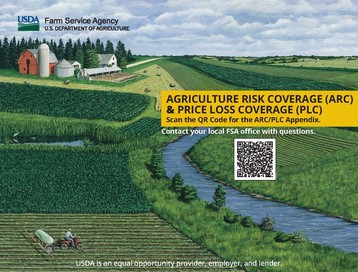
Agricultural producers can now change election and enroll in the Agriculture Risk Coverage (ARC) and Price Loss Coverage programs for the 2023 crop year, two key safety net programs offered by the U.S. Department of Agriculture (USDA). Signup began Monday, and producers have until March 15, 2023, to enroll in these two programs. Additionally, USDA’s Farm Service Agency (FSA) has started issuing payments totaling more than $255 million to producers with 2021 crops that have triggered payments through ARC or PLC.
2023 Elections and Enrollment
Producers can elect coverage and enroll in ARC-County (ARC-CO) or PLC, which provide crop-by-crop protection, or ARC-Individual (ARC-IC), which protects the entire farm. Although election changes for 2023 are optional, producers must enroll through a signed contract each year. Also, if a producer has a multi-year contract on the farm and makes an election change for 2023, they must sign a new contract.
If producers do not submit their election by the March 15, 2023 deadline, their election remains the same as their 2022 election for crops on the farm. Farm owners cannot enroll in either program unless they have a share interest in the farm.
Covered commodities include barley, canola, large and small chickpeas, corn, crambe, flaxseed, grain sorghum, lentils, mustard seed, oats, peanuts, dry peas, rapeseed, long grain rice, medium and short grain rice, safflower seed, seed cotton, sesame, soybeans, sunflower seed and wheat.
Web-Based Decision Tools
In partnership with USDA, the University of Illinois and Texas A&M University offer web-based decision tools to assist producers in making informed, educated decisions using crop data specific to their respective farming operations.
Tools include:
For more information on ARC and PLC, visit the ARC and PLC webpage or contact your FSA County office.
|
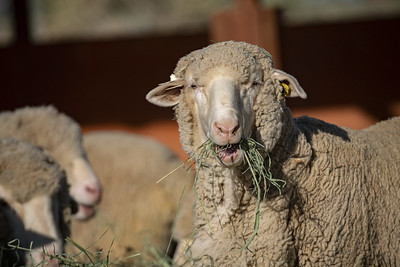
Wool and mohair producers are reminded that the deadline to apply for loans and LDP’s on wool shorn in calendar year 2022 is January 31, 2023.
|
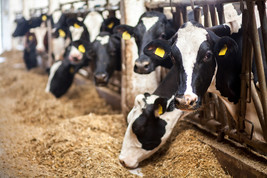
Producers Encouraged to Enroll As Soon As Possible
The U.S. Department of Agriculture (USDA) has extended the deadline for producers to enroll in Dairy Margin Coverage (DMC) and Supplemental Dairy Margin Coverage (SDMC) for program year 2023 to Jan. 31, 2023.
DMC is a voluntary risk management program that offers protection to dairy producers when the difference between the all-milk price and the average feed price (the margin) falls below a certain dollar amount selected by the producer.
Early projections indicate DMC payments are likely to trigger for the first eight months in 2023. Markets fluctuate, sometimes at a moment’s notice and sometimes with no warning at all, so now’s the time to ensure your operation is covered. Please don’t let this second chance slide.
Nearly 18,000 operations that enrolled in DMC for 2022 have received margin payments for August and September for a total of $76.3 million. At $0.15 per hundredweight for $9.50 coverage, risk coverage through DMC is a relatively inexpensive investment.
DMC offers different levels of coverage, even an option that is free to producers, aside from a $100 administrative fee. Limited resource, beginning, socially disadvantaged, and military veteran farmers and ranchers are exempt from paying the administrative fee, if requested. To determine the appropriate level of DMC coverage for a specific dairy operation, producers can use the online dairy decision tool.
Supplemental DMC
Last year, USDA introduced Supplemental DMC, which provided $42.8 million in payments to better help small- and mid-sized dairy operations that had increased production over the years but were not able to enroll the additional production. Supplemental DMC is also available for 2023. The enrollment period for 2023 Supplemental DMC is also extended to Jan. 31, 2023.
Supplemental DMC coverage is applicable to calendar years 2021, 2022 and 2023. Eligible dairy operations with less than 5 million pounds of established production history may enroll supplemental pounds.
For producers who enrolled in Supplemental DMC in 2022, the supplemental coverage will automatically be added to the 2023 DMC contract that previously established a supplemental production history.
Producers who did not enroll in Supplemental DMC in 2022 can do so now. Producers should complete their Supplemental DMC enrollment before enrolling in 2023 DMC. To enroll, producers will need to provide their 2019 actual milk marketings, which FSA uses to determine established production history.
DMC Payments
FSA will continue to calculate DMC payments using updated feed and premium hay costs, making the program more reflective of actual dairy producer expenses. These updated feed calculations use 100% premium alfalfa hay rather than 50%.
For more information on DMC, visit the DMC webpageor contact your local USDA Service Center.
USDA touches the lives of all Americans each day in so many positive ways. Under the Biden-Harris administration, USDA is transforming America’s food system with a greater focus on more resilient local and regional food production, fairer markets for all producers, ensuring access to safe, healthy and nutritious food in all communities, building new markets and streams of income for farmers and producers using climate smart food and forestry practices, making historic investments in infrastructure and clean energy capabilities in rural America, and committing to equity across the Department by removing systemic barriers and building a workforce more representative of America. To learn more, visit usda.gov.
|
Producers receiving program payments during calendar year 2022 will receive form IRS-1099-G detailing payments received from the Commodity Credit Corporation. The annual report of program payments on IRS-1099-G is a service intended to help our customers report taxable income. It is not intended to replace producer’s responsibilities to report income to IRS. The mailing of form IRS-1099-G will occur around January 31, 2023.
CCC will not issue form IRS 1099-G when CCC program payments total less than $600 for the calendar year. In addition, producers who receive program payments from multiple counties will receive only one IRS Form 1099-G showing all payments from all counties.
FSA staff will not attempt to interpret IRS regulations or advise producers about which payments to report on their income tax returns. However, county office staff can review payments for accuracy.
Although refund information is not shown on the IRS 1099-G, a customer’s financial data including refund information, program payment amounts, and prior year CCC-1099 information is conveniently available via the internet through the FSA “Financial Inquiries” database (FSA-FI). Instructions for obtaining a FSA-FI user ID and password are available on the FSA web site at: http://www.fsa.usda.gov/fmi

The Farm Service Agency (FSA) makes loans to youth to establish and operate agricultural income-producing projects in connection with 4-H clubs, FFA and other agricultural groups. Projects must be planned and operated with the help of the organization advisor, produce sufficient income to repay the loan and provide the youth with practical business and educational experience. The maximum loan amount is $5,000.
Youth Loan Eligibility Requirements:
- Be a citizen of the United States or a legal resident alien
- Be 10 years to 20 years of age
- Comply with FSA’s general eligibility requirements
- Be unable to get a loan from other sources
- Conduct a modest income-producing project in a supervised program of work as outlined above
- Demonstrate capability of planning, managing and operating the project under guidance and assistance from a project advisor. The project supervisor must recommend the youth loan applicant, along with providing adequate supervision.
For help preparing the application forms, contact your local USDA Service Center or visit fsa.usda.gov.
|
FSA’s Farm Storage Facility Loan (FSFL) program provides low-interest financing to producers to build or upgrade storage facilities, handling and drying equipment which includes on-farm liquified petroleum storage tanks to fuel grain dryers.
The low-interest funds can be used to build or upgrade permanent facilities to store commodities. Eligible commodities include corn, grain sorghum, soybeans, oats, wheat, barley, minor oilseeds harvested as whole grain, pulse crops (lentils, chickpeas and dry peas), hay, honey, fruits and vegetables for cold storage facilities, floriculture, hops, maple sap, rye, milk, cheese, butter, yogurt, meat and poultry (unprocessed), and eggs. Qualified facilities include grain bins, hay barns and cold storage facilities for eligible commodities.
Aggregate loan balances exceeding $100,000 require additional security in the form of real estate or an irrevocable letter of credit.
Producers do not need to demonstrate the lack of commercial credit availability to apply. The loans are designed to assist a diverse range of farming operations, including small and mid-sized businesses, new farmers, operations supplying local food and farmers markets, non-traditional farm products, and underserved producers.
To learn more about the FSA Farm Storage Facility Loan, visit www.fsa.usda.gov/pricesupport or contact your local FSA county office.
The Farm Service Agency (FSA) is accepting offers for specific conservation practices under the Conservation Reserve Program (CRP) Continuous Signup.
In exchange for a yearly rental payment, farmers enrolled in the program agree to remove environmentally sensitive land from agricultural production and to plant species that will improve environmental health and quality. The program’s long-term goal is to re-establish valuable land cover to improve water quality, prevent soil erosion, and reduce loss of wildlife habitat. Contracts for land enrolled in CRP are 10-15 years in length.
Under continuous CRP signup, environmentally sensitive land devoted to certain conservation practices can be enrolled in CRP at any time. Offers for continuous enrollment are not subject to competitive bidding during specific periods. Instead they are automatically accepted provided the land and producer meet certain eligibility requirements and the enrollment levels do not exceed the statutory cap.
For more information, including a list of acceptable practices, contact your local County USDA Service, or visit fsa.usda.gov.
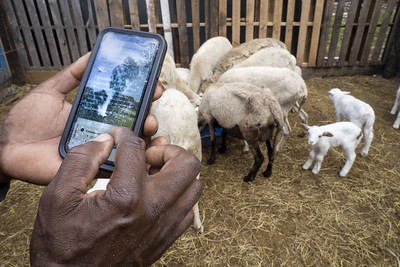
Livestock inventory records are necessary in the event of a natural disaster, so remember to keep them updated.
When disasters strike, the USDA Farm Service Agency (FSA) can help you if you’ve suffered excessive livestock death losses and grazing or feed losses due to eligible natural disasters.
To participate in livestock disaster assistance programs, you’ll be required to provide verifiable documentation of death losses resulting from an eligible adverse weather event and must submit a notice of loss to your local FSA office within 30 calendar days of when the loss of livestock is apparent. For grazing or feed losses, you must submit a notice of loss to your local FSA office within 30 calendar days of when the loss is apparent and should maintain documentation and receipts.
You should record all pertinent information regarding livestock inventory records including:
- Documentation of the number, kind, type, and weight range of livestock
- Beginning inventory supported by birth recordings or purchase receipts.
For more information on documentation requirements, contact your local County USDA Service, or visit fsa.usda.gov.
|
If you have experienced delays in receiving Agriculture Risk Coverage (ARC) and Price Loss Coverage (PLC) payments, Loan Deficiency Payments (LDPs) and Market Gains on Marketing Assistance Loans (MALs), it may be because you have not filed form CCC-941, Adjusted Gross Income Certification.
If you don’t have a valid CCC-941 on file for the applicable crop year you will not receive payments. All farm operator/tenants/owners who have not filed a CCC-941 and have pending payments should IMMEDIATELY file the form with their recording county FSA office. Farm operators and tenants are encouraged to ensure that their landowners have filed the form.
FSA can accept the CCC-941 for 2018, 2019, 2020, 2021, and 2022. Unlike the past, you must have the CCC-941 certifying your AGI compliance before any payments can be issued.
If you received a payment under the Wildfires and Hurricanes Indemnity Program+ (WHIP+) or the Quality Loss Adjustment Program (QLA) for crop production and/or quality losses occurring in 2018, 2019, or 2020 crop years, you are required to meet linkage requirements by obtaining federal crop insurance or Non-Insured Crop Disaster Assistance Program (NAP) coverage at the 60/100 level, or higher, for both the 2022 and 2023 crop years.
When applying for WHIP+ or QLA, form FSA-895 (Crop Insurance and/or NAP Coverage Agreement) was submitted acknowledging the requirement to obtain federal crop insurance, if available, or NAP coverage if federal crop insurance is not available. The coverage requirement is applicable to the physical location county of the crop that received WHIP+ and/or QLA benefits.
Producers should not delay contacting their federal crop insurance agent or local county FSA Office to inquire about coverage options, as failure to obtain the applicable coverage by the sales/application closing date will result in the required refund of WHIP+ benefits received on the applicable crop, plus interest. You can determine if crops are eligible for federal crop insurance or NAP by visiting the RMA website.
For more information, contact your Local County USDA Service Center or visit fsa.usda.gov.
If you received a payment under the Emergency Relief Program (ERP) for crop production losses occurring in 2020, 2021, or 2022 calendar years due to qualifying events occurring in calendar years 2020 or 2021, you are required to purchase crop insurance or NAP, as may be applicable for the crop, at a coverage level equal to or greater than 60 percent for insurable crops (60/100); or at the catastrophic level (50/55) or higher for NAP crops, for the next two available crop years. You can determine if crops are eligible for federal crop insurance or NAP by visiting the RMA website.
The next two available crop years are determined from the date you received your ERP payment. Example: Producer G received ERP benefits for 2021 rye losses and received an ERP payment in June of 2022. The sales closing date to purchase insurance for the 2023 crop year is September 30, 2022. Based on the date Producer G received ERP benefits, and the sales closing date for the crop, the next 2 available crop years for Producer G are 2023 and 2024.
The coverage requirement is applicable to the crop and the specific physical location of that crop. Please refer to your ERP application (FSA-520) to identify crops for which you received an ERP payment. Questions about physical location can be directed to your local county FSA office.
Failure to meet the linkage requirement will require you to refund ERP payments received on the applicable crop(s), plus interest.

FSA is cleaning up our producer record database and needs your help. Please report any changes of address, zip code, phone number, email address or an incorrect name or business name on file to our office. You should also report changes in your farm operation, like the addition of a farm by lease or purchase. You should also report any changes to your operation in which you reorganize to form a Trust, LLC or other legal entity.
FSA and NRCS program participants are required to promptly report changes in their farming operation to the County Committee in writing and to update their Farm Operating Plan on form CCC-902.
To update your records, contact your local County USDA Service Center.
|
When changes in farm ownership or operation take place, a farm reconstitution is necessary. The reconstitution — or recon — is the process of combining or dividing farms or tracts of land based on the farming operation.
To be effective for the current Fiscal Year (FY), farm combinations and farm divisions must be requested by August 1 of the FY for farms subject to the Agriculture Risk Coverage (ARC) and Price Loss Coverage (PLC) program. A reconstitution is considered to be requested when all of the required signatures are on FSA-155 and all other applicable documentation, such as proof of ownership, is submitted.
Total Conservation Reserve Program (CRP) and non-ARC/PLC farms may be reconstituted at any time.
The following are the different methods used when doing a farm recon:
-
Estate Method — the division of bases, allotments and quotas for a parent farm among heirs in settling an estate
-
Designation of Landowner Method — may be used when (1) part of a farm is sold or ownership is transferred; (2) an entire farm is sold to two or more persons; (3) farm ownership is transferred to two or more persons; (4) part of a tract is sold or ownership is transferred; (5) a tract is sold to two or more persons; or (6) tract ownership is transferred to two or more persons. In order to use this method, the land sold must have been owned for at least three years, or a waiver granted, and the buyer and seller must sign a Memorandum of Understanding
-
DCP Cropland Method — the division of bases in the same proportion that the DCP cropland for each resulting tract relates to the DCP cropland on the parent tract
-
Default Method — the division of bases for a parent farm with each tract maintaining the bases attributed to the tract level when the reconstitution is initiated in the system.
Husbands and wives may sign documents on behalf of each other for FSA and Commodity Credit Corporation programs in which either has an interest. This option is automatically available unless a written request for exclusion is made to the county office staff by either spouse.
There are exceptions to the rule. Spouses may not sign FSA-211’s on behalf of each other or sign on behalf of the other as an authorized signatory for partnerships, joint ventures, corporations or other similar entities. Spouses must have a power of attorney on file or sign personally for claim settlements, such as promissory notes, and on security documents for price support loans.
Individual signatures are also required on certain Farm Loan Program and Farm Storage Facility Loan documents.
A spouse’s authority to sign documents on behalf of the other spouse does not entitle the spouse to review or receive agency records of the other spouse.
 January 16, 2023: Offices closed in observance of Martin Luther King Day
January 30, 2023: 2022 ELAP Application for Payment Deadline
January 30, 2023: 2022 LFP Application for Payment Deadline
January 31, 2023: Deadline to enroll in 2023 DMC Coverage
January 31, 2023: Deadline to apply for loans and LDP’s on wool shorn in calendar year 2022
February 20, 2023: Offices closed in observance of Presidents Day
March 1, 2023: 2022 LIP Application for Payment Deadline
March 15, 2023: 2023 ARCPLC Enrollment Deadline
March 15, 2023: 2023 NAP Coverage Deadline - Spring Planted Crops
March 15, 2023: 2023 NAP Coverage Deadline - Perennial and Other Forage
July 31, 2023 – Deadline to apply for re-enrollment of CRP Continuous offers
Ongoing – Continuous CRP Signup
Farm Operating Loans: Direct: 5.125%
Farm Ownership Loans Direct: 5.250%
Farm Ownership Loans (Down Payment): 1.500%
Emergency Loans: 3.750%
Farm Storage Facility Loan, 3 year: 4.125%
Farm Storage Facility Loan, 5 year: 3.750%
Farm Storage Facility Loan, 7 year: 3.750%
Farm Storage Facility Loan, 10 year: 3.625%
Farm Storage Facility Loan, 12 year: 3.625%
Commodity Loans: 5.750%
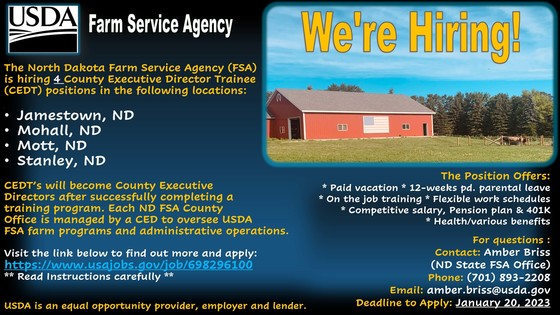
|